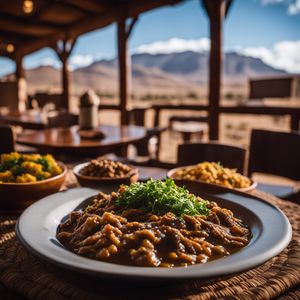
Dish
Sapie
Sapie is made from glutinous rice that is mixed with coconut milk and salt. The mixture is then wrapped in banana leaves and steamed until cooked. The spicy sauce is made from chili peppers, garlic, shallots, and shrimp paste. Sapie is a popular snack in Sulawesi and is often served at special occasions such as weddings and festivals.
Origins and history
Sapie has been a traditional dish in Sulawesi for centuries. It is believed to have originated from the Toraja people who live in the highlands of the island. The dish is often served at funerals and other important events as a symbol of respect for the deceased.
Dietary considerations
Glutinous rice makes this dish unsuitable for those with gluten intolerance. The shrimp paste in the sauce may also be problematic for those with shellfish allergies.
Variations
There are many variations of sapie, with different regions and families having their own unique recipes. Some versions include meat or vegetables in the filling, while others use different types of rice or sauces.
Presentation and garnishing
Sapie is typically presented on a banana leaf or other decorative plate. It is often garnished with fresh herbs or sliced chili peppers.
Tips & Tricks
To make the perfect sapie, it is important to use high-quality ingredients and to steam the rice cakes until they are fully cooked. The spicy sauce should be made fresh and served warm.
Side-dishes
Sapie is often served with a side of fresh vegetables such as cucumber or tomato. It can also be paired with a spicy sambal or other condiments.
Drink pairings
Sapie is traditionally served with a hot cup of tea or coffee. However, it can also be paired with a cold beer or soft drink.
Delicious Sapie recipes
More dishes from this category... Browse all »

Alambre
Mexican cuisine

Anticucho
Peruvian cuisine

Apanado de alpaca
Peruvian cuisine

Avar khinkal
Georgian cuisine

Bandeja paisa
Colombian cuisine

Banska kapama
Bulgarian cuisine

Barbecue Ribs
American cuisine

Bauernschmaus
Austrian cuisine
More cuisines from this region... Browse all »

Botswana cuisine
Spicy, Savory, Hearty

Cuisine of Eswatini
Spicy, Savory, Hearty

Cuisine of Lesotho
Spicy, Savory, Hearty

Malawian cuisine
Spicy, Flavorful, Hearty

Mauritian cuisine
Spicy, Flavorful, Aromatic

Mozambican cuisine
Spicy, Flavorful, Tangy, Savory, Sweet

Namibian cuisine
Bold and unique flavors (combination of sweet, sour, spicy flavors)

Seychellois cuisine
Bold and unique flavors (combination of sweet, sour, spicy flavors)

